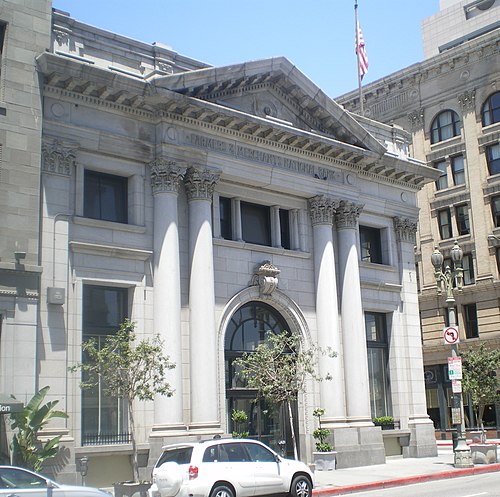 | This article includes a list ofgeneral references, butit lacks sufficient correspondinginline citations. Please help toimprove this article byintroducing more precise citations.(October 2012) (Learn how and when to remove this message) |
| Farmers and Merchants Bank | |
|---|---|
 Farmers and Merchants Bank, 2008 | |
 Interactive map of Farmers and Merchants Bank | |
| Location | 401 S. Main Street Los Angeles |
| Architectural style | Classical Revival style |
| Designated | August 9, 1983 |
| Reference no. | 271 |
Farmers and Merchants Bank (F&M) was a lending institution (1871−1952) based inDowntown Los Angeles,California. It is recognized both for its architecture and its pivotal role in the economic development of early Los Angeles. Other, non-related "F&M Banks" exist in various cities and towns across theUnited States.
The Farmers and Merchants Bank was founded in 1871 by 23 prominent Los Angeles businessmen, with an initial capital of $500,000. The three largest subscribers were financierIsaias W. Hellman ($100,000), former California GovernorJohn G. Downey ($100,000), andOzro W. Childs ($50,000) who in later years became the founders of theUniversity of Southern California. Other investors included CharlesDucommun ($25,000), I.M. Hellman ($20,000), and Jose Mascarel ($10,000.). Its original location was at thePico Building, onMain Street, between what is nowUS 101 and Temple, roughly at the site of theTriforium.[1]
The Farmers and Merchants Bank was the first incorporated bank in Los Angeles, founded in 1871 byIsaias W. Hellman.[2]
The bank built and moved into new offices designed by architectEzra F. Kysor in 1874 across the street from the Pico Building. The Los Angeles National Bank moved into its facilities in the Pico Building. In 1883 the F&M Bank moved again, to Main and Commercial streets.[3]
I.W. Hellman, was a cautious lender, insisting that major borrowers have good character and provide good security. Its subsequent presidents, J.A. Graves (who had been Hellman's attorney) and Victor H. Rosetti, continued Hellman's conservative practices, with a large portion of the bank's capital constantly held in Treasury securities. As a result, the Bank survived every economic panic period, from thePanic of 1873,Panic of 1893, andPanic of 1896, through theGreat Depression.

However, a one-branch downtown bank was eventually seen as not likely to continue to grow. In 1956, it merged with Security First National Bank, which became in later yearsSecurity Pacific National Bank, and ultimately was acquired by theBank of America.
The location of the bank prior to 1905 was on the southeast corner of Main and Commercial streets.[4]
Designed in theClassical Revival style, the 1905 Farmers and Merchants Bank remains one of Southern California's finest examples of the early "temples of finance" which were popular at the turn of the century. Its two-story facade, reminiscent of aRoman temple, is punctuated by an entrance framed withCorinthian columns topped by a large triangular pediment. Built in 1905, the bank was designed by the firm ofMorgan and Walls.[5]
The Farmers & Merchants Bank building has been established asLos Angeles Historic-Cultural Monument#271.

Much of the original banking room remains, including light fixtures, a centralskylight, and theloggia with itsVictorian-style railings. Operating as a bank until its closure in the late 80s, the building now functions primarily as a special events and banquet facility and film location. The building is slated for renovation by developer Tom Gilmore and Associates.[6]
34°2′53.2″N118°14′50.9″W / 34.048111°N 118.247472°W /34.048111; -118.247472